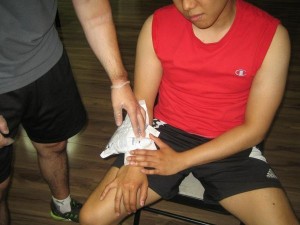
Hand-foot-and-mouth disease is a common viral infection that takes place in young children. As the name implies, the infection causes a rash on the hands and feet and sores in the mouth.
Hand-foot-and-mouth disease is a mild viral infection, generally caused by a coxsackievirus.
Hand-foot-and-mouth disease does not have a specific treatment. However, you can reduce the risk of contracting the infection by teaching your children proper hygiene which includes frequent and thorough hand washing.
Signs and symptoms
Signs and symptoms of hand-foot-and-mouth disease include:
- Fever
- Malaise – feeling of being sick
- Sore throat
- Loss of appetite
- A red rash on the palms, soles of the feet and on the buttocks at times as well – the rash may not cause any itching but may accompany blistering
- Sores on the tongue, inside of the cheeks and gums
- Irritability, particularly in infants and young children
Usually the infection starts off with a fever, which is normally followed by sore throat and other symptoms such as malaise and suppressed appetite. After a few days of the onset of fever, painful sores begin to occur in the mouth and throat. Rashes on the hand, feet and buttocks may follow within the next couple of days.
When to seek medical attention
See your doctor if your child is having trouble drinking fluids due to the sores in the mouth and throat. Consult your doctor if symptoms seem to be worsening.
Treatment
There is no specific treatment for this infection. Symptoms often go away within 7-10 days.
Pain and mouth sores can be treated with a topical anesthetic. Over-the-counter pain killers such as ibuprofen and acetaminophen may relieve discomfort and pain.
There are certain foods and drinks that can irritate the sores in the mouth and tongue. The following approaches may relieve discomfort and allow children to eat and drink more with less trouble:
- Eat ice cream
- Suck on popsicles, ice chips or ice pops
- Drink cold fluids such as ice water or milk
- Avoid acidic drinks and foods such as citrus fruits, fruit juices, fizzy drinks and soda
- Avoid having spicy or salty foods
- Offer soft foods to your child as they do not require a lot of chewing
- Make sure your child rinses his or her mouth after every meal
If you are sure that your child can rinse without swallowing the liquid, you can consider a warm salt water rinse as well. A salt water rinse can be made out ½ teaspoon of salt diluted in one cup of water. Make sure your child rinses his mouth frequently with a warm salt water solution or as much as possible to reduce symptoms such as pain and inflammation.
Related topics:
